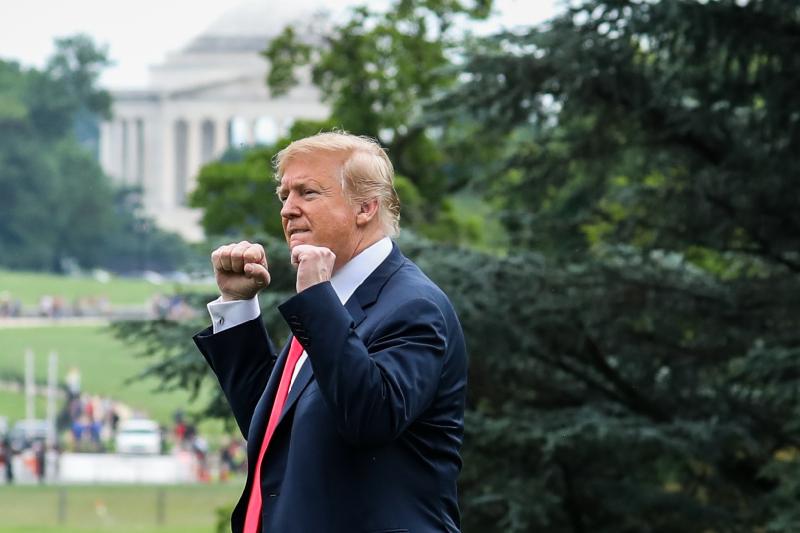Does Trump Deserve Credit For the Economy? The Numbers Say No.



H ow much credit does Donald Trump deserve on the economy? Based on the data, not much.
Presidents deserve credit on the economy when their policy changes leave most people better off by creating conditions that stimulate employment, growth, investment, or consumer spending. While Donald Trump’s tax-and-spending program, approved by the GOP Congress in late 2017, has certainly changed economic conditions, it’s still early for a final judgment on Trump’s record. The results so far, however, suggest his policies have only weakened the economy.
Let’s start with jobs. The jobless rate today is 3.6 percent. But unemployment had fallen steadily for more than six years before Trump took office, from 10 percent in October 2009 to 4.7 percent in January 2017. Since Trump’s program was enacted in December 2017, the jobless rate has fallen from 4.1 percent to 3.6 percent.
But the official data from the Bureau of Labor Statistics show that the decline in joblessness has actually slowed under Trump’s policies: In the 17 months before Trump’s program went into effect, unemployment dropped by 12.5 percent of its total decline since 2010. In the 17 months since Congress passed his program, it’s dropped by just 8 percent of that total decline.
Trump is correct that the economy has grown faster after his policies took effect: Real GDP growth has accelerated—from 2.5 percent in 2017 to 2.9 percent in 2018 and 3.1 percent in the first quarter of 2019. But a deeper dive into the data shows that Trump’s policies had almost nothing to do with it.
The administration’s policy approach was to spur business investment sufficiently to sustain higher growth. In October 2017, as Congress debated Trump’s tax proposals, the head of his Council of Economic Advisors (Kevin Hassett) predicted that the business tax changes would provide a “boost to capital spending and then GDP growth.”
But the Bureau of Economic Analysis (BEA) reports that business investment has contributed less to GDP growth since December 2017 than it did before. In fact, with the exception of the beginning of 2018—immediately following the passage of the GOP’s big tax breaks for corporations and other businesses—business investment has slowed down.
From then until now, real fixed business investment has grown just 4.3 percent—a significant slowdown from the 6.3 percent gains that took place from the end of 2016 to the end of 2017, when the tax breaks were passed.
What’s more, Trump’s policies have not boosted consumer spending. This key indicator of economic health also has slowed since December 2017: Personal consumer spending grew 2.9 percent in the five quarters since Congress enacted Trump’s program—less than the 3.4 percent gains in the five quarters before his policies became law.
Equally disconcerting, Trump’s approach to trade hasn’t helped the economy. Trump repeatedly promised to reduce the trade deficit and imposed new tariffs within months of taking office. Yet the trade deficit has increased sharplyunder his tenure, rising from $503.0 billion in 2016 to $550.1 billion in 2017 to $627.7 billion in 2018. For context: While the trade deficit jumped by $125 billion over Trump’s first two years as president, it increased by just $13 billion over Obama’s last two years in office.
Based on the Bureau of Economic Analysis’s GDP reports, the only factors boosting growth since Trump’s policies took effect have been inventory changes and rising government spending. But since the inventory changes are happening independent of Trump, his only real basis for claiming credit for the economic state of our nation is that his policies have briefly goosed the economy by expanding budget deficits.
Presidents can affect federal spending from nearly the time they take office. The non-partisan Congressional Budget Office (CBO) reports that over Trump’s first two years as president, his policies increased the budget deficit by 33.3 percent. At the same time, revenue changes also drive what happens to the budget deficit, and Trump’s tax breaks have reduced federal revenues significantly. Since they took effect in January 2018, the deficit has jumped more than 17 percent.
But the past may be prologue, because things are only looking to get worse. The CBO has projected that budget deficits under Trump will keep rising this year and in 2020 and beyond. If the CBO is correct, the deficit will jump more than 54 percent during Trump’s first term. Here, too, the contrast with Obama is stark: In the last four years of his presidency, the budget deficit fell by more than 46 percent.
In the opening rally for his 2020 campaign Wednesday night, Trump insisted that the economy is “soaring to incredible new heights,” which, he said, is “perhaps the greatest economy we’ve had in the history of our country.’’
But the data don’t lie. His policies have failed to boost business investment and consumer spending. Nor have they reduced the trade or budget deficits. It’s unsurprising that both the CBO Outlook and the latest consensus forecast by Wall Street economists concur that the U.S. economy is slowing down. That’s what Trump can honestly take credit for.

